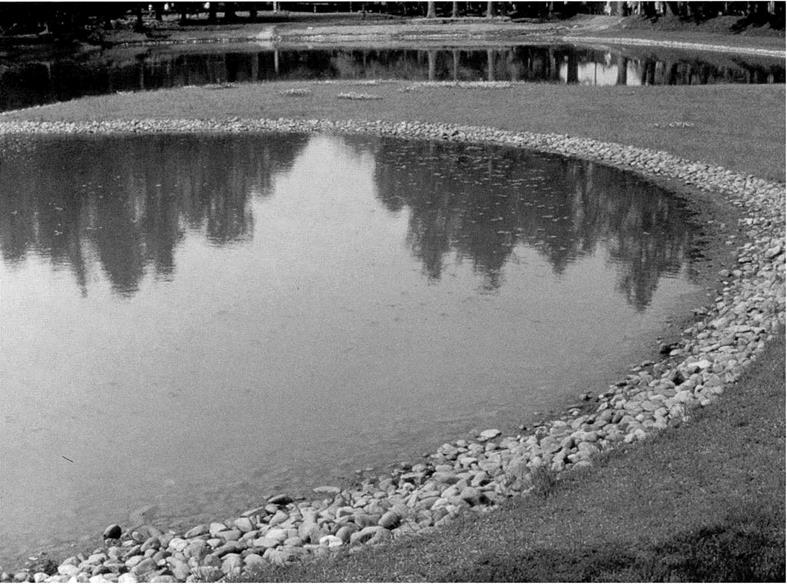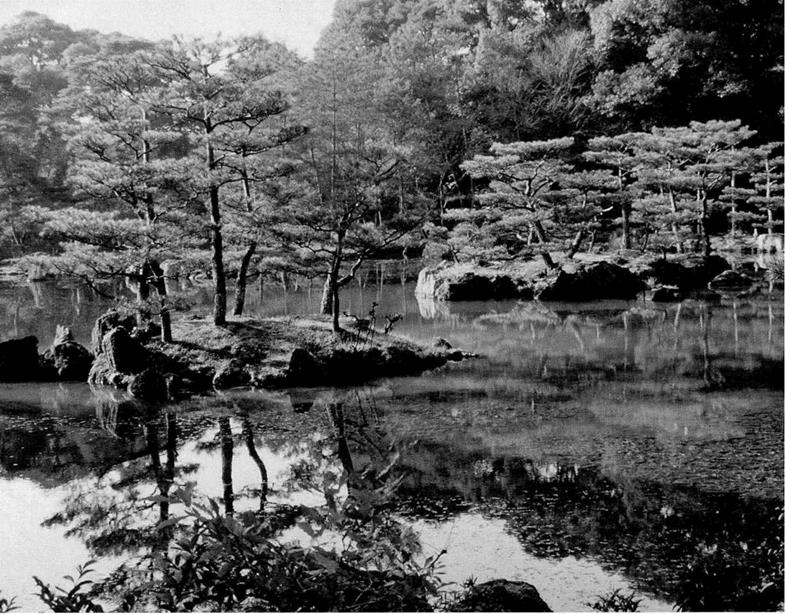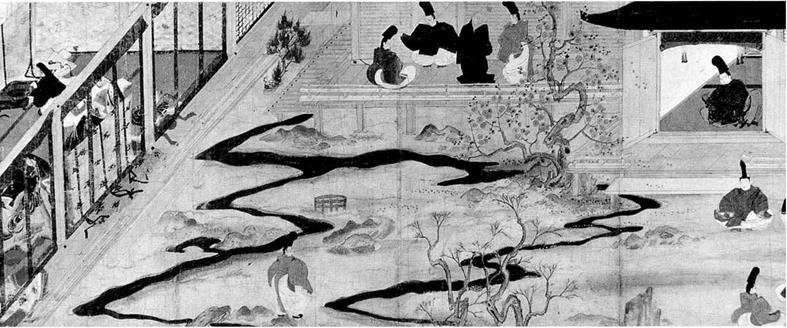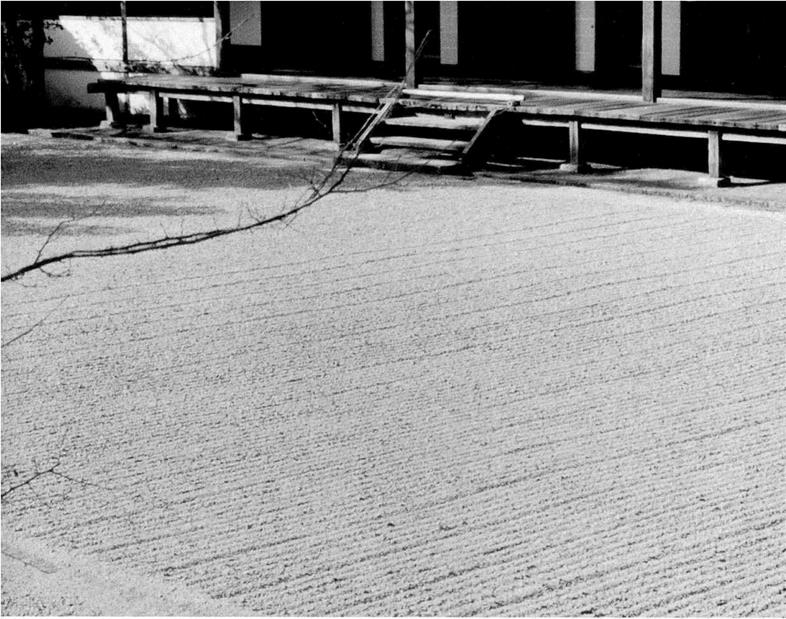The prototype of garden design is described in the opening paragraphs of Sakuteiki, while the remainder of the text presents the Japanese garden’s six basic compositional elements—the artificial hills, the pond, the island, the white sand south garden, the garden stream, and the waterfall—and also notes that plants and springs may be used as garden accents where appropriate (Figures 10.1— 10.6). Through the historical periods—even when later abstracted or condensed—the skeletal structure of the Japanese garden is composed using these six elements to portray the natural landscape in accordance with the prototype. Having defined and documented these alone makes Sakuteiki a classic.
Sakuteiki outlines the six basic compositional elements of the garden as:
Artificial Hills
… [T ] heir surroundings are landscaped [with artificial hills] to embellish the architecture. This was mentioned early in such a book as the Illustrated Scripture of Jeta Vana (gion zukyd).1′
Pond
Since the stones in the pond landscape are placed to simulate a seascape, be sure to install the “deep-rooted rock” and the “wave-repelling stone” in the scenery.22
In [the Ocean Style], first construct the scene of a rough seashore.. ,23
[The River Style] should resemble a meandering tract of a dragon or a snake.24
Islands
About the various types of the pond island landscape. They are: the Hill Island, the Field Island, the Forest Island, the Rocky-Shore Island, the Cloud Shape, the Running Stream Type, the Ebb-tide Beach Style, the Pine-bark Pattern, and so on.25
South Garden
Concerning the layout of the South Garden (nantei), the distance of sixty to seventy feet will be required from the outer pillars supporting the roof of the
|
|

◄ 10.1 Artificial hill garden landscape from the Muromachi period. Manpukuji, Shimane Prefecture.
 |
![The Six Basic Elements of Garden Composition Подпись: types of the six compositional elements exist as general concepts unaffected by the actual one-cho space. Trees and Shrubs The majority of Sakuteiki’s contents focuses on stones and water. The work’s longest chapters are on stones, the stream, and the waterfall, in that order. The subject of trees is touched upon relatively lightly, while mountains, hillside fields and shrubbery are not even treated in independent sections. A chapter entitled “About Tree Planting” focuses mostly on the geomantic significance of the placement of trees in relation to the dwelling, and on various taboos, or warnings which are couched in highly superstitious lan-guage but provide very practical, aesthetically pleasing garden-making advice. Garden historian Tamura Tsuyoshi gives the following explanations of the scarcity of discus-sion of trees and shrubs in his critical work on Sakuteiki: As the various techniques regarding the placement of stones are applicable en toto to trees and shrubs, [their explanation in Sakuteiki] was abbreviated to avoid redundancy. ... As the craft of tree planting falls within the domain of farming and gardening, it was, and for the most part still is, considered the work of the garden supplier, only rarely to be handled by a designer. Although [Sakuteiki] covers construction to some extent, the text is devoted primarily to the aspect of design. The placement of stones was considered to be the most taxing area of study [in garden design], and planting a less worthwhile pursuit. Since plants must for the most part, conform to the laws of nature, they have severe limitations as design elements, which are difficult to overcome. It was probably for these rea-sons that lengthy coverage was not provided.30 Stone setting is the essential point of Sakuteiki The place-ment of stones was the basis of garden design in the Heian](/img/1316/image018.png) |
◄ 10.2 Pond simulating the shoreline of a sandy beach, Motsuji, Iwate Prefecture.
|
10.3 Pond island landscape of Kokyd no ike (Mirror pond) at Kinkakuji, Kyoto. |
|
10.4 View of the garden stream in relation to the shinden from the early-thirteenth-century handscroll Kitano tenjin engi (Legends of Kitano Shrine), Kitano Shrine, Kyoto. National Treasure. |
|
|
|
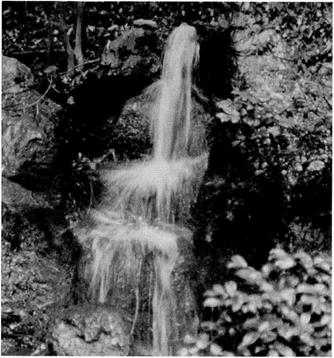
period and for centuries afterward. In fact the term “stone setting” (ishidate) is synonymous with “garden making.”
In spring, flowers distract the eye, and in summer, foliage envelopes and conceals the garden. It is only in the dead of winter, when the trees lose their leaves, that the skeletal structure of the garden is revealed. In winter it becomes clear that the placement of stones forms the framework of the garden plan, and that stones are the single expressive element that remains unchanged. Trees and plants, by contrast, change constantly. They reflect more the will of the many hands to which they have been subject over the years than the original garden design.
Implicit in Sakuteikis advice to designers to consider “how much [space] would be left for the pond” is the understanding that stone setting forms the skeletal structure of the garden plan, while trees and plants serve as decorative accents. By the Edo period (1603-1867), however, both plants and stones were used to create the compositional structure of the garden, as is evidenced by the clipped shrub formations found in these gardens. In landscape composition of the garden beginning at this time, a balance was sought between structural elements and changing elements, or accent planting; thus plants began to be used as part of the unchanging structural plan. Shrub clipping at the temple Daichiji in Minakuchi, Shiga Prefecture—its garden comprised solely of clipped shrubs—is traditionally performed by the head priest, as an “inherited duty” (Figure 11).

